1995 CADILLAC ELDORADO tires
[x] Cancel search: tiresPage 8 of 395

Downloaded from www.Manualslib.com manuals search engine For the 1948 model. Cadillac
introduced the
which set
the trend in automotive
styling for nearly
two decades. This
was followed by the 1949 model with
the
rwo door hardiop Coupe DeVilIe
and the modern overhead valve,
high co-pression
V8 engine.
Engineering
innervations, con-
veniences and styling dotninated
the
'50s and '60s. Cruise controli auto-
matic climate control,
tiit and
telescoping steering wheels, twilight
sentinel and four door hard tops
all
debuted in these years. In 1957 the
Eldorado Brougham featured
ad-
vances such as air suspension, mem-
ory
seat, automatic electric d.oor
locks, transistor radio, a brushed stainless steel
roof and
low profile
tires.
introduced in
1953, was redesigned for t967 as the
first front wheel drive personal
lux-
ury car. The 472 cu. in. V8 engine
used-
in all Cadillacs in 1968 and
1969 was enlarged to 500 cu. in. for
all 1970 Eldorados.
An
Air Cushion Restraint Sys-
tem (airbag) was available for 1974,
1975 and
1976 Cadillacs.
Analog Electronic Fu.el Injec-
tion was available, on
1975 Cadillacs
and was standard on the new inter-
national size 1976 Sevifle. In
1978,
the Trip Computer option incor-
. porated an on-board microprocessor.
Page 152 of 395
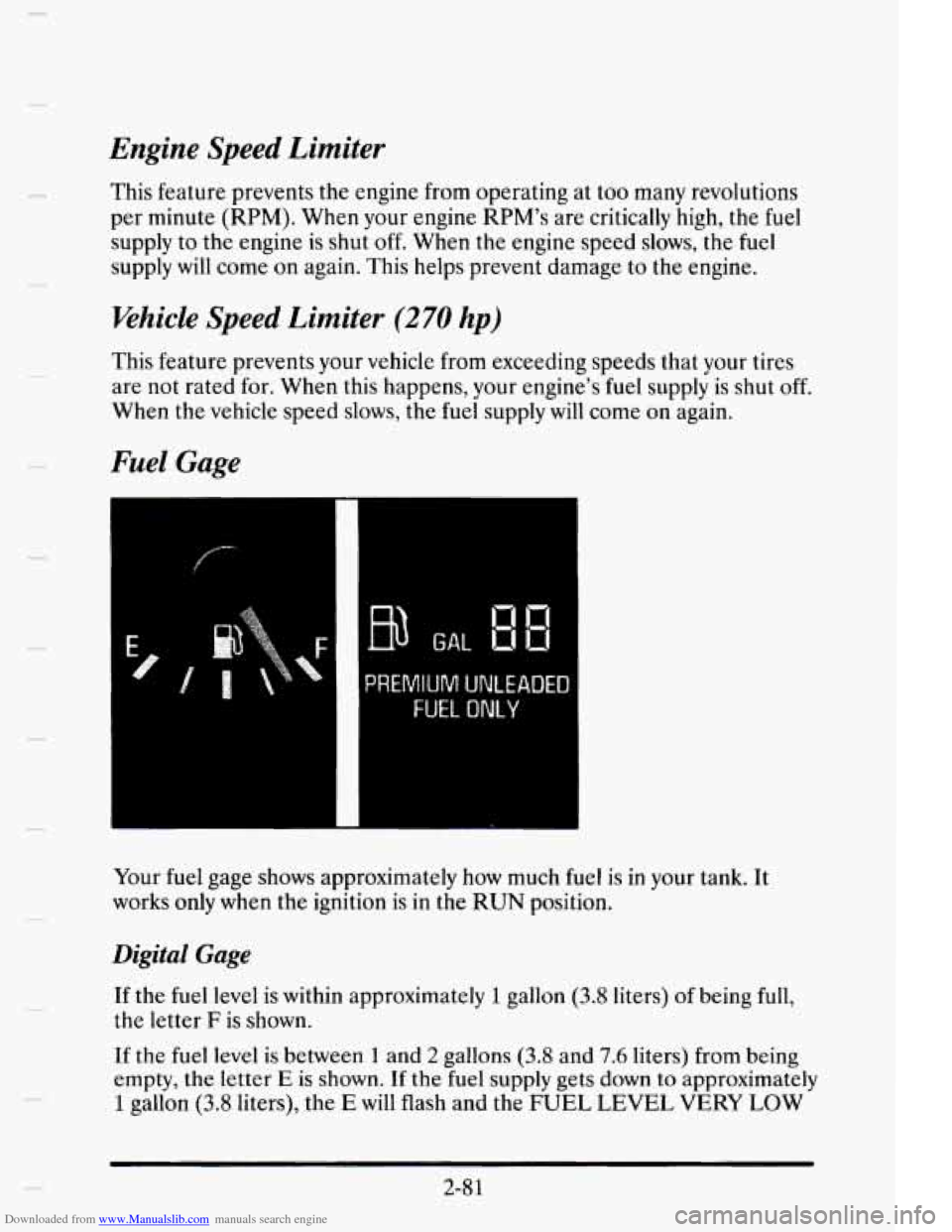
Downloaded from www.Manualslib.com manuals search engine Engine Speed Limiter
This feature prevents the engine from operating at too many revolutions
per minute
(RPM). When your engine RPM’s are critically high, the fuel
supply to the engine is shut
off. When the engine speed slows, the fuel
supply will come on again. This helps prevent damage to the engine.
Khicle Speed Limiter (270 hp)
c
This feature prevents your vehicle from exceeding speeds that your tires
are not rated for. When this happens, your engine’s fuel supply is shut
off.
When the vehicle speed slows, the fuel supply will come on again.
Fuel Gage
PREMIUM UNLEADED
FUEL ONLY
Your fuel gage shows approximately how much fuel is in your tank. It
works only when the ignition is in the RUN position.
Digital Gage
If the fuel level is within approximately 1 gallon (3.8 liters) of being full,
the letter
F is shown.
If the fuel level is between 1 and 2 gallons (3.8 and 7.6 liters) from being
empty, the letter
E is shown. If the fuel supply gets down to approximately
1 gallon (3.8 liters), the E will flash and the FUEL LEVEL VERY LOW
2-8 1
Page 192 of 395

Downloaded from www.Manualslib.com manuals search engine CONTROL OF A VEHICLE
You have three systems that make your vehicle go where you want it to go.
They are the brakes, the steering and the accelerator. All three systems
have to do their work at the places where the tires meet the road.
. . ..-
Sometimes, as when you’re driving on snow or ice, it’s easy to ask more of
those control systems than the tires and road can provide. That means you
can lose control
of your vehicle.
BRAKING
Braking action involves perception time and reaction time.
First, you have to decide
to push on the brake pedal. That’sperception
time. Then you have to bring up your
foot and do it. That’s reaction time.
Average reaction time is about
314 of a second. But that’s only an average.
It might be less with one driver and as long as
two or three seconds or
more with another.
Age, physical condition, alertness, coordination, and
eyesight all play a part.
So do alcohol, drugs and frustration. But even in
3/4 of a second, a vehicle moving at 60 mph (100 km/h) travels 66 feet
(20 m). That could be a lot of distance in an emergency, so keeping
enough space between your vehicle and others is important.
And,
of course, actual stopping distances vary greatly with the surface of
the road (whether it’s pavement or gravel); the condition of the road (wet,
dry, icy); tire tread; and the condition
of your brakes.
4-5
Page 197 of 395
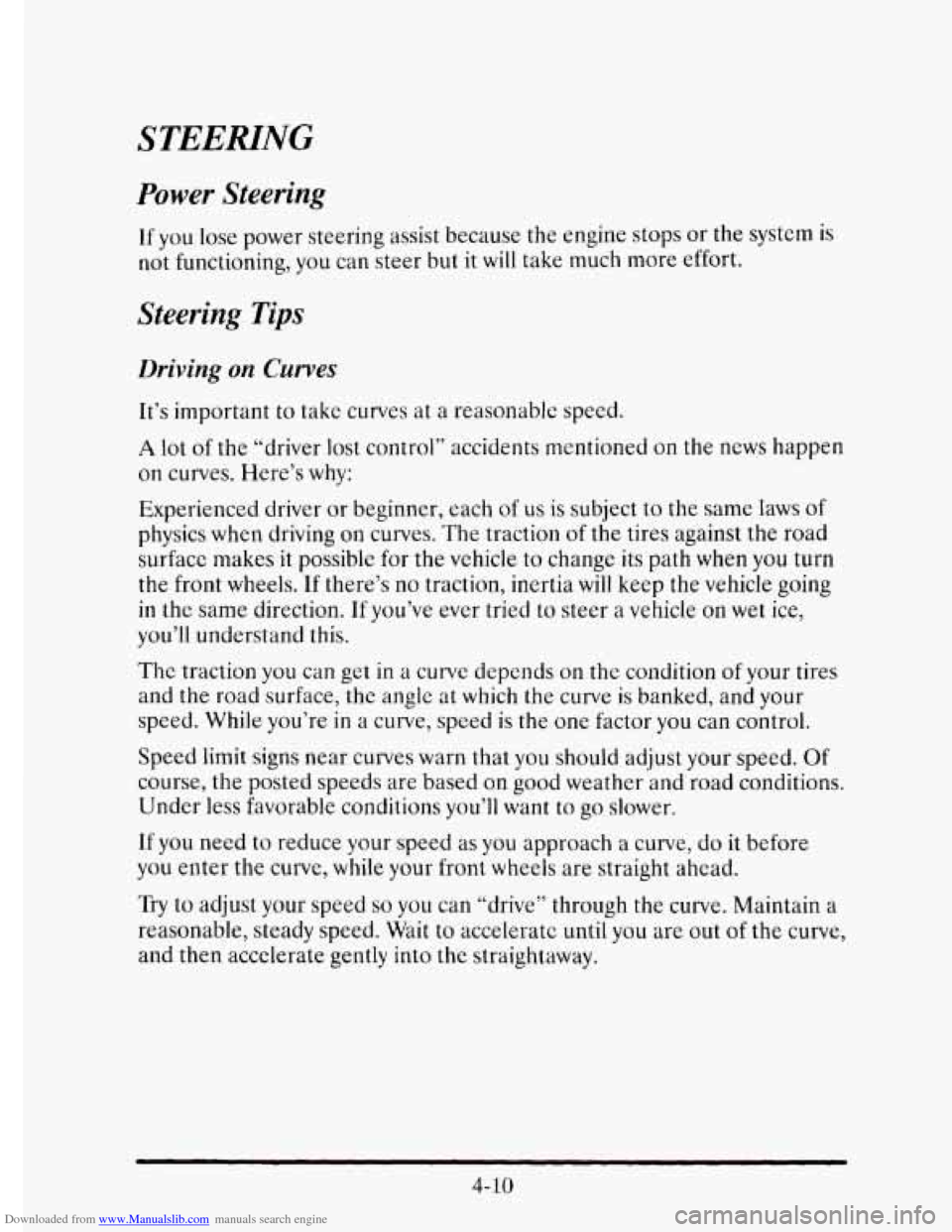
Downloaded from www.Manualslib.com manuals search engine STEERING
Power Steering
If you lose power steering assist because the engine stops or the system is
not functioning, you can steer but it will take much more effort.
Steering Tips
Driving on Curves
It’s important to take curves at a reasonable speed.
A lot of the “driver lost control’’ accidents mentioned on the news happen
on curves. Here’s why:
Experienced driver or beginner, each
of us is subject to the same laws of
physics when driving on curves. The traction of the tires against the road
surface makes
it possible for the vehicle to change its path when you turn
the front wheels.
If there’s no traction, inertia will keep the vehicle going
in the same direction. If you’ve ever tried to steer a vehicle on wet ice,
you’ll understand this.
The traction you can get
in a curve depends on the condition of your tires
and the road surface,
the angle at which the curve is banked, and your
speed. While you’re
in a curve, speed is the one factor you can control.
Speed limit signs near curves warn that you should adjust your speed.
Of
course, the posted speeds are based on good weather and road conditions.
Under
less favorable conditions you’ll want to go slower.
If you need to reduce your speed as you approach a curve, do it before
you enter
the curve, while your front wheels are straight ahead.
Try to adjust your speed so you can “drive” through the curve. Maintain a
reasonable, steady speed. Wait
to accelerate until you are out of the curve,
and then accelerate gently into
the straightaway.
4- 10
Page 201 of 395
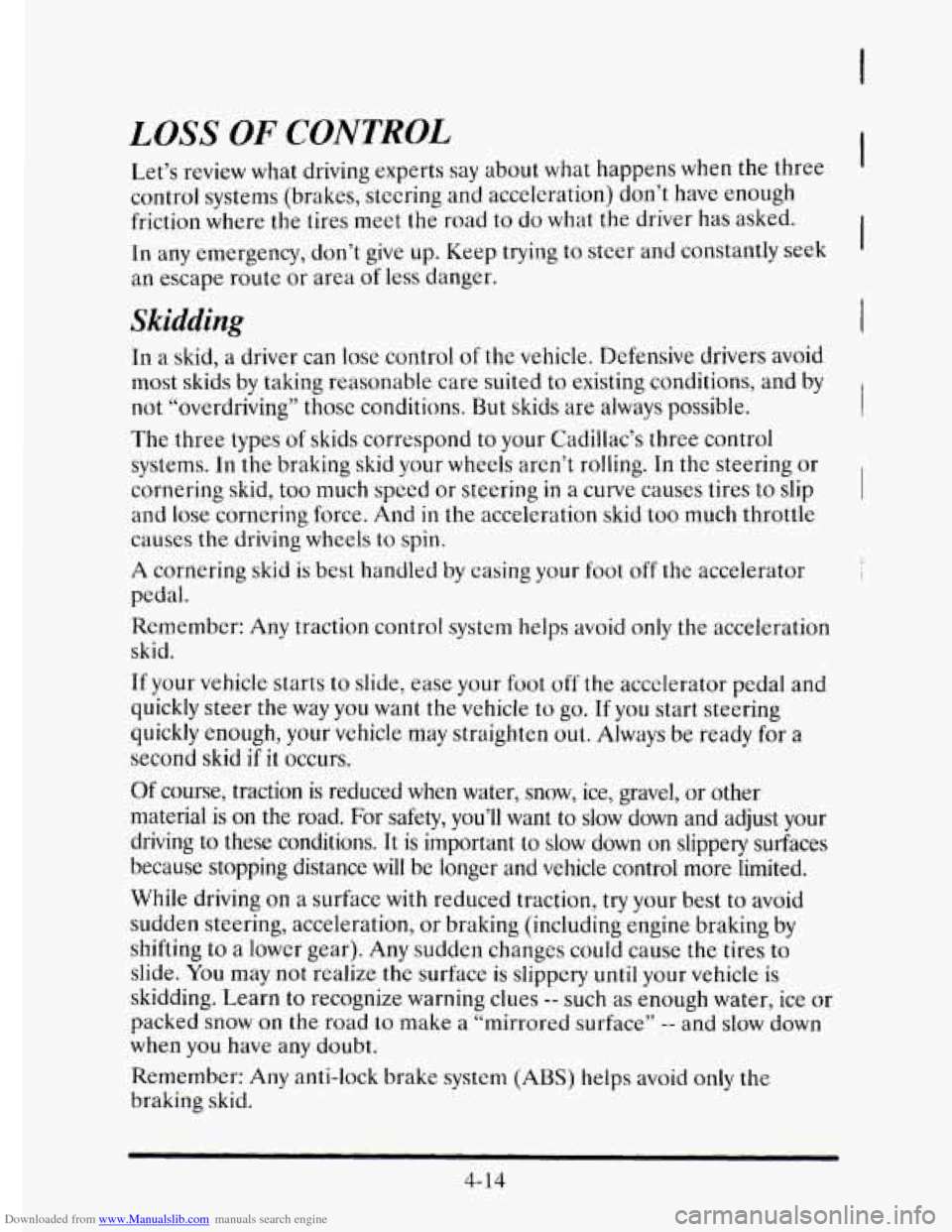
Downloaded from www.Manualslib.com manuals search engine LOSS OF CONTROL
Let’s review what driving experts say about what happens when the three
control systems (brakes, steering and acceleration) don’t have enough
friction where the tires meet
the road to do what the driver has asked.
In any emergency, don’t give up. Keep trying to steer and constantly seek
an escape route or area
of less danger.
Skidding
In a skid, a driver can lose control of the vehicle. Defensive drivers avoid
most skids by taking reasonable care suited to existing conditions, and by
not “overdriving” those conditions. But skids are always possible.
The three types
of skids correspond to your Cadillac’s three control
systems. In the braking skid your wheels aren’t rolling.
In the steering or
cornering skid, too much
speed or steering in a curve causes tires to slip
and
lose cornering force. And in the acceleration skid too much throttle
causes the driving wheels
to spin.
A cornering skid is best handled by casing your foot off the accelerator
pedal.
Remember: Any traction control system helps avoid only the acceleration
skid.
If your vehicle starts
to slide, ease your foot off the accelerator pedal and
quickly steer the way
you want the vehicle to go. If you start steering
quickly
enough, your vehicle may straighten out. Always be ready for a
second skid
if it occurs.
Of course, traction is reduced when water, snow, ice, gravel, or other
material is on
the road. For safety, you’ll want to slow down and adjust your
driving to these conditions.
It is important to slow down on slippery surfaces
because stopping distance
will be longer and vehicle control more limited.
While driving on a surface with reduced traction,
try your best to avoid
sudden steering, acceleration,
or braking (including engine braking by
shifting to a lower gear). Any sudden changes could cause
the tires to
slide. You may not realize the surface is slippery until your vehicle is
skidding. Learn
to recognize warning clues -- such as enough water, ice or
packed snow
on the road to make a “mirrored surface” -- and slow down
when
you have any doubt.
Remember:
Any anti-lock brake system (ABS) helps avoid only the
braking skid.
4- 14
Page 204 of 395
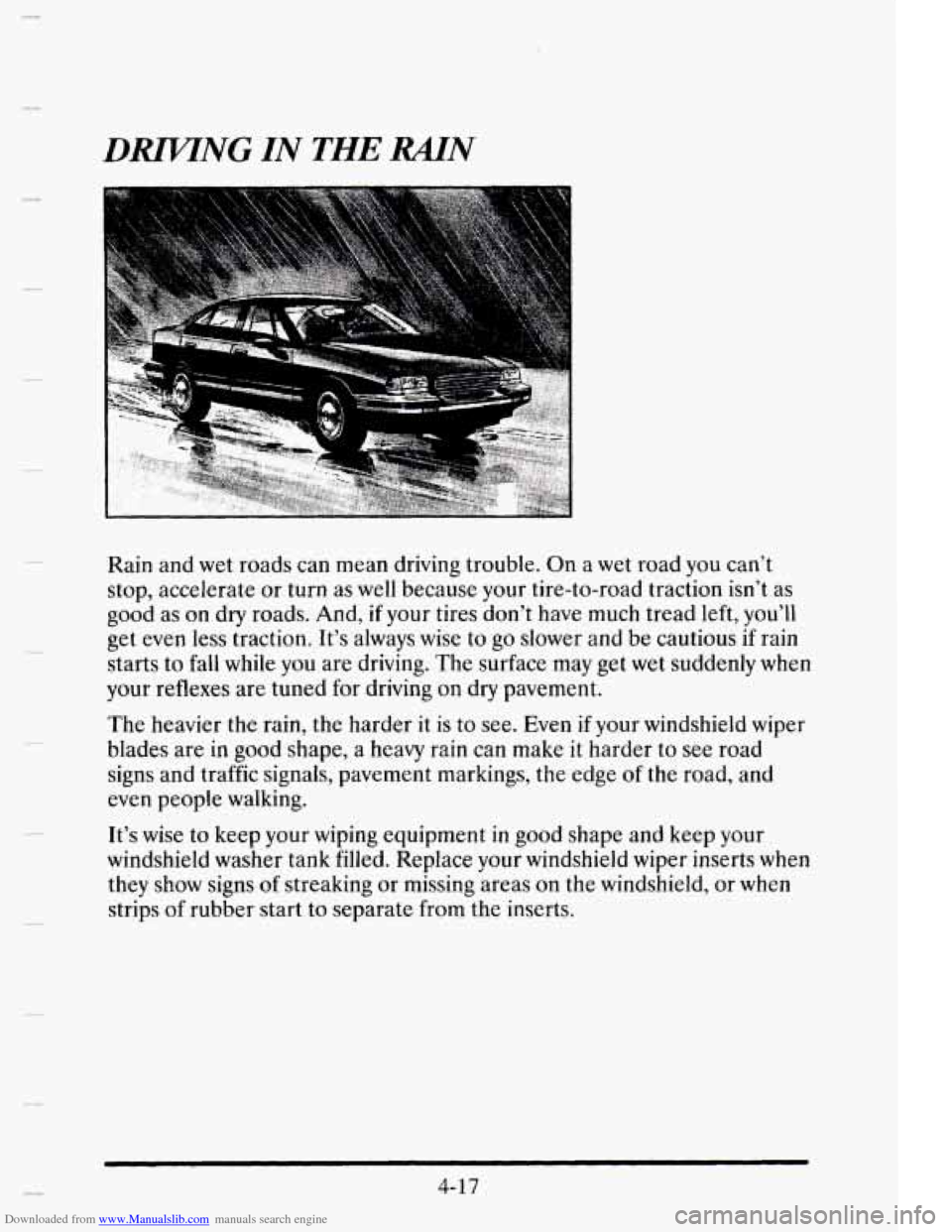
Downloaded from www.Manualslib.com manuals search engine DMNG IN THE RAIN
Rain and wet roads can mean driving trouble. On a wet road you can’t
stop, accelerate or turn as well because your tire-to-road traction isn’t as
good as
on dry roads. And, if your tires don’t have much tread left, you’ll
get even
less traction. It’s always wise to go slower and be cautious if rain
starts to fall
while you are driving. The surface may get wet suddenly when
your reflexes are tuned for driving on dry pavement.
The heavier
the rain, the harder it is to see. Even if your windshield wiper
blades are
in good shape, a heavy rain can make it harder to see road
signs and traffic signals, pavement markings, the edge
of the road, and
even people walking.
It’s wise
to keep your wiping equipment in good shape and keep your
windshield washer tank filled. Replace your windshield wiper inserts when
they show signs of streaking or missing areas on the windshield, or when
strips of rubber start to separate from the inserts.
4-17
Page 206 of 395
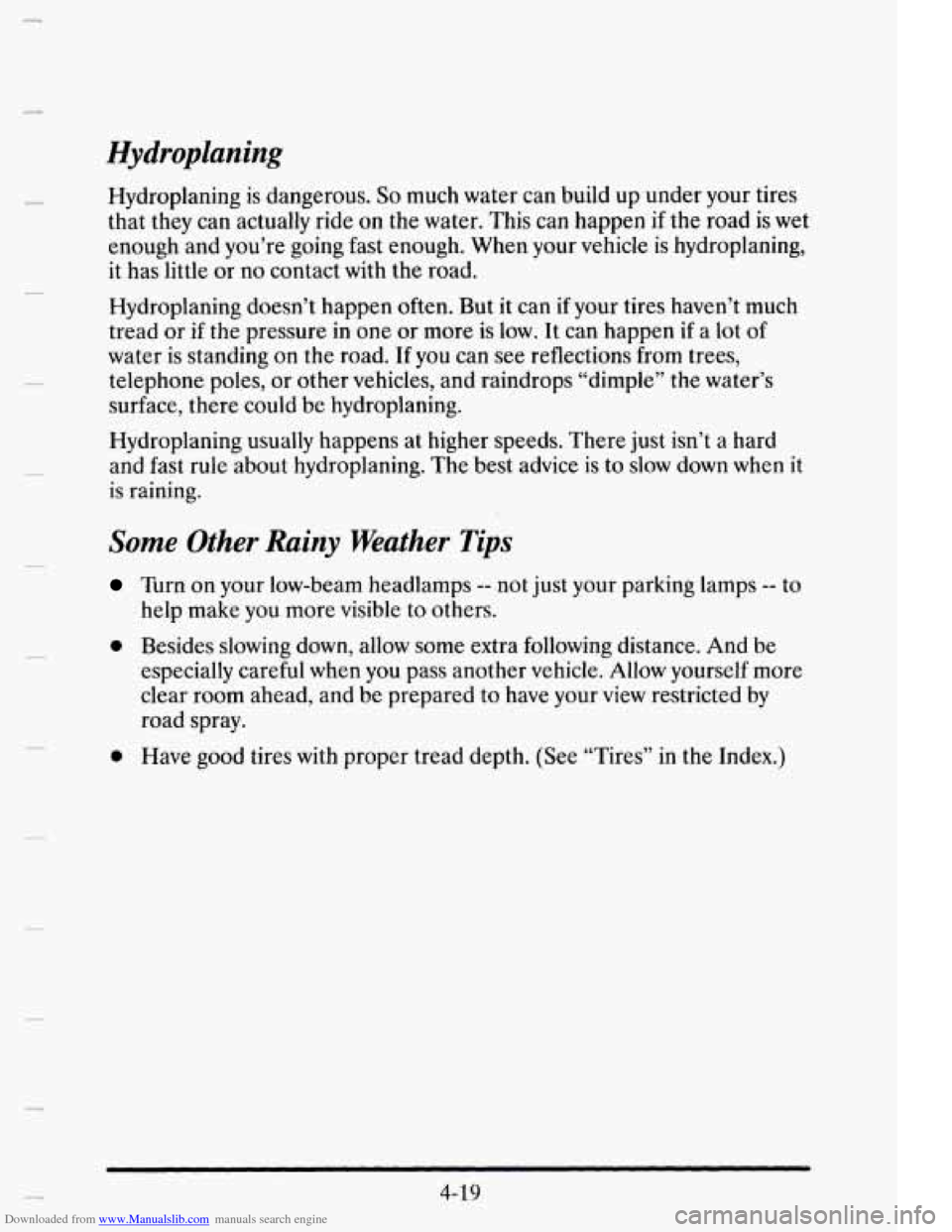
Downloaded from www.Manualslib.com manuals search engine Hydroplaning
Hydroplaning is dangerous. So much water can build up under your tires
that they can actually ride
on the water. This can happen if the road is wet
enough and you’re going fast enough. When your vehicle
is hydroplaning,
it has little or no contact with the road.
Hydroplaning doesn’t happen often. But it can
if your tires haven’t much
tread or
if the pressure in one or more is low. It can happen if a lot of
water is standing
on the road. If you can see reflections from trees,
telephone poles, or other vehicles, and raindrops “dimple’’ the water’s
surface, there could
be hydroplaning.
Hydroplaning usually happens at higher speeds. There just isn’t a hard
and fast rule about hydroplaning.
The best advice is to slow down when it
is raining.
Some Other Rainy Weather Tips
Turn on your low-beam headlamps -- not just your parking lamps -- to
help make you more visible to others.
0 Besides slowing down, allow some extra following distance. And be
especially careful when you pass another vehicle. Allow yourself more
clear room ahead, and be prepared
to have your view restricted by
road spray.
0 Have good tires with proper tread depth. (See “Tires” in the Index.)
4- 19
Page 209 of 395
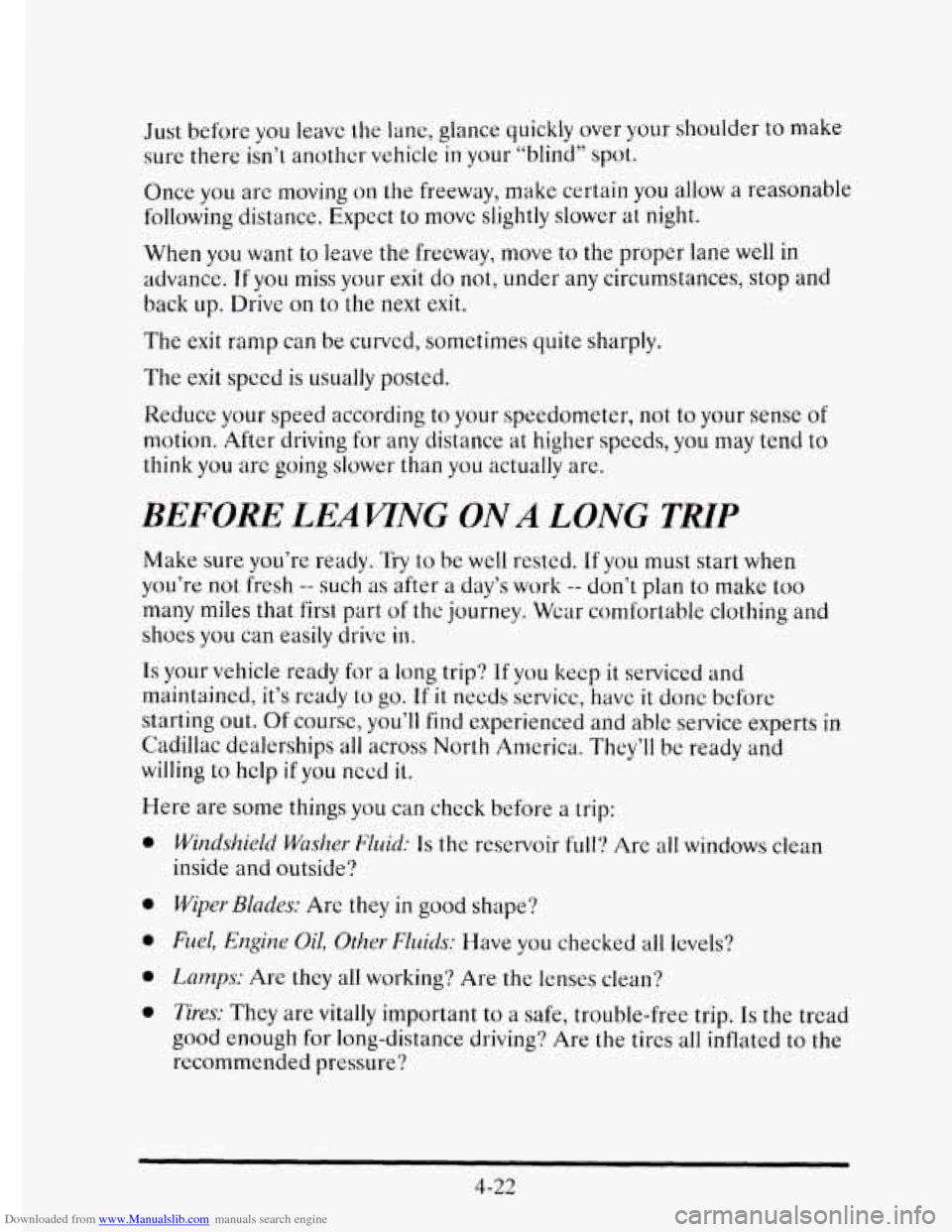
Downloaded from www.Manualslib.com manuals search engine Just before you leave the lane, glance quickly over your shoulder to make
sure there
isn’t anothcr vehicle in your “blind” spot.
Once you are moving on the freeway, make certain
you allow a reasonable
following distance. Expect
to move slightly slower at night.
When you want to leave the freeway, move to the proper lane well in
advance. If you miss your exit do not, under any circumstances, stop and
back up. Drive on to the next exit.
The exit ramp can be curved, sometimes quite sharply.
The
exit speed is usually posted.
Reduce your speed according
to your speedometer, not to your sense of
motion. After driving for any distance at higher speeds, you may tend to
think you are going slower than you actually are.
BEFORE LEAVTNG ONA LONG TRlP
Make sure you’re ready. Try to be well rested. If you must start when
you’re not fresh
-- such as after a day’s work -- don’t plan to make too
many
miles that first part of the journey. Wear comfortable clothing and
shoes
you can easily drive in.
Is your vehicle ready for a long trip? If you keep it serviced and
maintained, it’s ready
to go. If it needs service, have it done before
starting out.
Of course, you’ll find experienced and able service experts in
Cadillac dealerships all across North America. They’ll be ready and
willing
to help if you need it.
Here are some things you can check before a trip:
a
0
a
0
a
WindshieEd Wusher Fluid: Is the reservoir full? Are all windows clean
inside and outside?
Wiper. Blades: Are they in good shape‘?
Fzd, Engine Oil, Other Fluids: Have you checked all levels?
Lnmnps: Are they all working? Are the lenses clean?
Tires: They are vitally important to a safe, trouble-free trip. Is the tread
good enough for long-distance driving? Are the tires all inflated to the
recommended pressure?
4-22